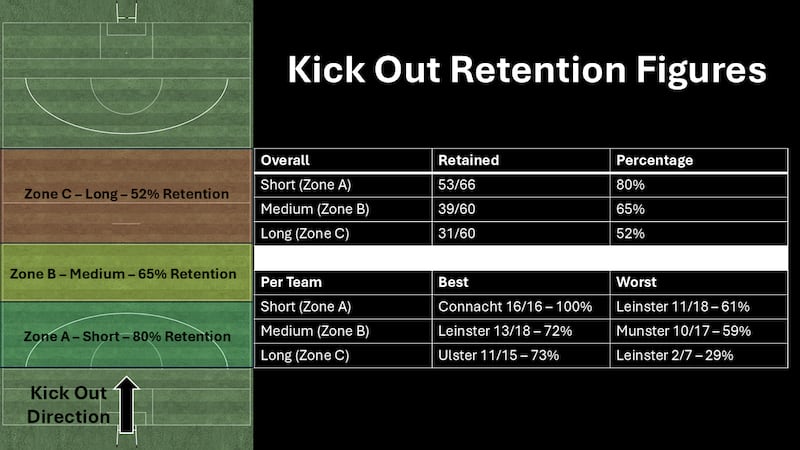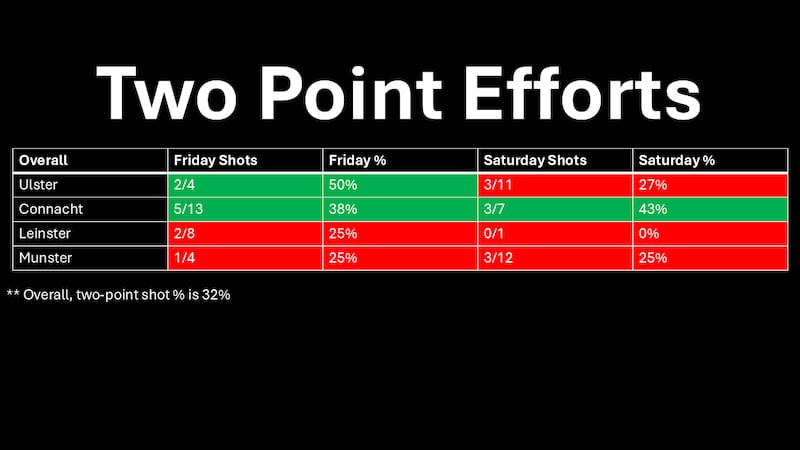The change in field markings, specifically the 40-metre arc – which is in place as an area the kickout must go beyond and an incentive to shoot from distance – led to significant changes in the Interprovincial games played in Croke Park over the weekend. There are other rules of course, but we are going to look at the game in terms of this new marking on the pitch.
As mentioned by others, any analysis of the action comes with caveats – there is limited training completed so far, the games don’t have the serious consequences that championship games would have, and there is an element of experimentation by both players and coaches. In short, the sample size is too small, but we have at least seen the direction that things might take.
Kickouts
We got lots of contests on the kickouts and the range of a team’s goalkeeper and the succinctness of the team’s movement ahead of him is going to lead to interesting and expansive kickout plans. Also, we may see that teams give up on the short kickout as time progresses, as the one thing evident was the lack of the out ball back to the goalkeeper – a welcome addition, as it is currently too difficult for teams to press an opposition’s short kickout.
The extra distance the kickout needs to travel outside the arc, even means the short kickout inside the 45 comes with risk. There was only an 80 per cent (53/66) retention rate on these short kickouts over the four games. For context in the final three games of the 2024 season, the two semi-finals and final, there were a total of 93 short kickouts inside the 45m, and the retention on these was 98 per cent (91/93). To further emphasis the change the 40-metre arc presents, it is worth noting that 84 of those 93 short kickouts were kicked into what would now be the exclusion zone. In other words, the kickout has been given a complete facelift.
Inside Gaelic Games: The weekly GAA newsletter from The Irish Times
Worth the wait: How Kieran McGeeney came through the criticism to show his managerial quality
‘It’s been a privilege’ - Dessie Farrell steps down after Dublin fail to step up against Tyrone
Tyrone beat Dublin as Dessie Farrell steps down from post - as it happened

The dismantling of Stephen Cluxton in the first half on Friday night meant Connacht led at half time 1-18 to 0-7. Cluxton only retained 7/17 kickouts, well below his usual retention figures. This was a huge platform for Connacht as they managed to score 0-8 (six one-pointers and one two-pointer) off these 10 kickouts. This pressure exerted on the opposition kickout led to an unassailable gap opening by half time. This type of territorial supremacy could see games becoming non-contests very quickly. It could also allow teams to gather much wanted momentum in a game they are chasing, and enable them to claw back leads.
Attacking structure
There were shots galore in the games. It was only Connacht v Leinster that failed to break the shot-a-minute mark. The two games on Friday had 59 and 63 shots respectively, while the two games on Saturday both had 62 shots. This is a huge number of efforts but it is unlikely to be something we see going forward, due to the low conversion rates of the shots.
To give context on the volume of the shots, over the weekend the interprovincial teams had a shot every 59 seconds, while if we look back to the higher stakes All-Ireland semi-finals and final, there was on average a shot every 85 seconds. The shooting figures in those games (over 70 minutes rather than 60 minutes) were Galway v Armagh (43 shots), Galway v Donegal (53 shots) and Armagh v Kerry (66 shots over 90 minutes).
A huge difference but this must be put alongside the pressure and consequence of shooting.

The success rate on the two-pointers was low at 19/60 (32 per cent), but as players practise shooting from range and the importance of long-distance free-taking rises, expect these conversion figures to improve.
The interesting aspect of the volume of two-point shots is the different approach teams took on both evenings. Leinster took eight on Friday and that was down to just one effort on Saturday. As they shot from distance repeatedly on Friday, a big gap opened on the scoreboard. While in contrast Ulster were far more reserved on Friday, with only four shots, but this number almost tripled the following evening.
It is difficult to look at these figures in absolute terms, as the defensive set-up the attacking team is faced with, and the perceived opportunities for working the ball to the inside line are hard quantify. It does help if teams have go-to, two-point shooters, with Rian O’Neill, Niall Morgan and Johnny Heaney all managing to get off multiple shots over the weekend from the two-point region.
The final three minutes of the final on Saturday were the advertisement the FRC were looking for. An excellent two-pointer by Galway’s Johnny Heaney starts the sequence. Then Connacht have possession outside the attacking 45 and they seek to work the ball to the inside line. Ulster turns it over and break, before looking for the reward of a two-point effort from Rian O’Neill; that drops short but goes to the net thanks to the fist of Odhran Murdock.
As the countdown clock moved on Heaney kicks another booming two-pointer to send the affair to penalties, seconds before the Hooter.
Connacht were 20 per cent (1/5) from two-point efforts before the two clutch kicks by Heaney, bringing their overall two-point conversion rate up to 43 per cent (3/7).
The scoring system has managed to create a different defensive shape for teams, as they must protect the edges of the 40-metre arc and close the two-point shooter. As mentioned, the conversion rate was low on two-point efforts (19/60 or 32 per cent), but the reward is high, and there is also the element of chaos in front of the goal, like that which led to Murdock’s goal.
This new defensive structure at times left swathes of space in front of the full forward line, in the D area. There were some well-executed kick passes from the outside of the arc to the inside, but the inside man who won the ball had to come back out due to isolation (see Kevin Feely in the video). Other times this ball was cut out well by defenders (see Rian O’Neill’s kick inside in videos), while the support runs made by Diarmuid O’Connor (for Munster against Ulster) or Matthew Tierney (for Connacht against Ulster), show the kind of chances that can be created in these circumstances.
Across all four games there was certainly adventure and experimentation from the teams, which is positive to see. You could also see some evolution across the course of the games and even quarter by quarter. It was great to see the likes of the Armagh trio of Aidan Forker, Paddy Burns and Rian O’Neill talk with such inquisitive clarity on the game over the weekend and this bodes well for the direction things will go. Although it is when the stakes are high that we will see a truer version of what the rules have changed.
Paul O’Brien is a performance analyst with The Performance Process (twitter.com/NoPlanBGAA).














